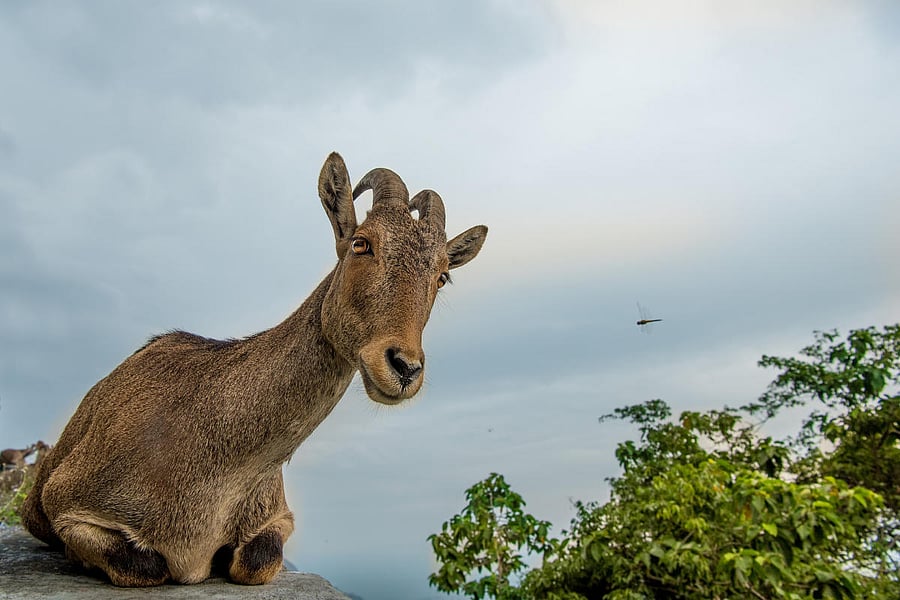

The grass is verdant and tender in the crisp dawn air, carpeting the rolling hills of Eravikulam National Park.
In the early morning, the hills echo with the lilt of the Palani laughingthrush’s singing while a flash of colour peppers the landscape as the black-and-orange flycatcher swoops from a nearby tree.
Eravikulam located along the Western Ghats in the Idukki and Ernakulam districts of Kerala hosts a unique landscape. The park consists of rolling hills covered in high-altitude grasslands interspersed with sholas or patches of stunted montane tropical forests.
Stray bits of grass drop from the grizzled muzzle of the strange resident goat-antelope of the blue hills. The Nilgiri tahr is an odd-looking ungulate – hooved animal – that is actually more closely related to sheep rather than goats. Found only in the montane tropical grasslands of India, it is the largest among the three tahrs in the world along with the Himalayan tahr and the Arabian tahr.
Found mainly in the ghats of Kerala and Tamil Nadu, the largest population of Nilgiri tahr can be seen in the Eravikulam National Park. Known as the ‘saddleback’ because of its unique colouration, especially in males, the Nilgiri tahr is small compared to India’s other ungulates but equipped with sturdy hooves, horns pointing backwards, and a slender body, perfect for hopping up and down rocky slopes. Their saddle patch changes colours as they age and their life expectancy is just three years.
The tahr is one of India’s finest mountaineers, and its relative in the high Himalayas relies on this mountaineering skill to evade predators like the agile snow leopard and the Himalayan wolf. However, the Nilgiri tahr is more interested in scaling the hills in search of tender leaves and grass to eat.
While this goat (or rather a sheep) is normally shy, tourism has made a bit of a pet out of this wild animal. On the road to Anamalai from Eravikulam, if you pause your vehicle along the scenic road in the high elevation stretches, you will see at least a handful of tahr milling about the side of the road, accepting ‘bribes’ and partaking in selfies with tourists. I stared in disgust the first time I witnessed this.
Threats to wild animals
Wild animals across India face a multitude of threats from anthropogenic sources, one of which is the disappearing barrier between humans and animals. While ecotourism has made great strides in promoting urban dwellers to care about conservation and forests, it has also exposed wildlife to hoards of people, many of whom are not educated about how to act around wild animals.
When I visited the forests of Nagarahole, I saw people driving along the forest road stopping their vehicles and getting out to click selfies alongside a variety of animals and birds, from peacocks and chital to gaur and elephants, which can easily gore or trample a person who wanders too close!
The same can be seen on the road to Anamalai, but macaques, langurs, and the Nilgiri tahr are the chief guests in these selfies.
Irresponsible people also halt to feed chips and biscuits to the tahr, creating quite a riot as these ungulates are now associating humans with easy food and prefer to linger on the roadside instead of foraging in the wild, placing them at risk of vehicular accidents. Can too much affection be dangerous? Well, in the case of feeding the tahr, yes indeed!
Streaks of red in the green
I stared across the blushing hills of the Nilgiris at the tiny herd of saddlebacks grazing on the fresh grass. The monsoon was in full sway in Eravikulam, and the tahrs were absorbed in piling on the nutrients. I lifted my head, inhaling the scent of rain in the wind. As though mimicking me, one of the tahrs lifted its slender head as well, scenting the air. I smiled, and then my eyes widened as I spotted a slinking red blob in the shola forest to the left of the grassy expanse where the saddlebacks grazed. A wild dog!
Suddenly, the breeze picked up, and the small herd of tahr raised their heads in unison, scenting the dhole in the wind. I fumbled for my binoculars and spotted not one, not two, but four wild dogs slinking towards the tahr, their reddish-brown bodies hidden in the tall grass. The biggest saddleback made a loud harrumphing sound and the animals wheeled as one, bounding away.
The dogs gave chase, streaks of red in a field of green, their bodies stretched nearly flat as they pursued the disappearing tahr. Both predator and prey vanished over the hilltop, and an echoing silence descended on the place they had been just moments before.
I sighed and turned to go. The saddlebacks would be back tomorrow, but for today, they had vanished like shadows into the blue hills of the Nilgiris.
(The author is with Ashoka Trust for Research in Ecology and the Environment, Bengaluru)